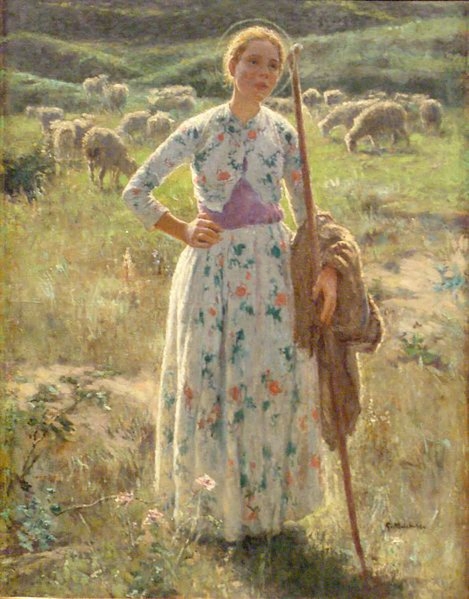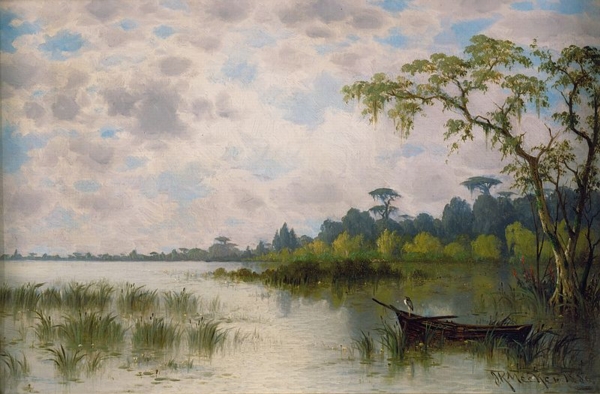
Scholarly Text from Private
Sources

(above, Gari Melchers, Joan of
Arc, oil on canvas, 30 x 23 inches, Indianapolis Museum of Art.
Public domain, via Wikimedia Commons*)
Resource Library has amassed considerable information covering many artists and
topics. In late 2016 Traditional Fine Arts Organization
(TFAO), publisher of Resource Library, changed focus away from adding
additional articles and essays. TFAO is instead concentrating on furthering
breadth and depth of information from other sources to place in Topics in American Art. In early 2017 TFAO added
hundreds of additional museums to it's list for ongoing study. Find the
covered museums here: A-C D-G
H-L M-Q
R-S T-Z.
For the indefinite future TFAO plans for Resource Library
to remain inactive while accumulating data for Topics in American Art.
 An emphasis of Resource
Library, a publication of Traditional
Fine Arts Organization (TFAO), is making available to its online readers
scholarly texts beneficial for the study of representational
art in the United States covering numerous topics
and artists throughout the nation's
history. For a list of Resource Library's published authors and a
count of their articles and essays please see the Author
Study and Index.
An emphasis of Resource
Library, a publication of Traditional
Fine Arts Organization (TFAO), is making available to its online readers
scholarly texts beneficial for the study of representational
art in the United States covering numerous topics
and artists throughout the nation's
history. For a list of Resource Library's published authors and a
count of their articles and essays please see the Author
Study and Index.
Since 1996, hundreds of grantors of permissions to Resource
Library have done so due to its editorial reputation, archival stability
and a myriad of other benefits to them and the public.
While the majority of texts published by Resource Library
are accepted from institutional
sources, topical articles and essays from individuals and other private
sources are also published. Texts with solid educational and historic value
are welcomed from other sources including individual writers, artist organizations,
commercial art gallery owners, independent curators, freelance writers,
print magazine owners and others. Texts from galleries are often essays
from exhibition catalogues.

(above: Joseph Rusling Meeker, Bayou
Landscape, 1886, oil on canvas, 18 x 27 inches, Morris Museum of
Art, Augusta, Georgia. Public domain, via Wikimedia Commons*)
Why is this publication
valuable to the public?
Comprehensive source
- Resource Library is the most
comprehensive online source of information on American representational
art. It is of value to scholars, teachers, students, individuals Shaping an Art Collection and the general
public worldwide.
-
Information on authors
- For each article or essay attributable to a named author,
Resource Library welcomes a 100-150 word narrative biography of
the author to enable readers to become familiar with the author's education
and accomplishments. This knowledge helps readers judge scholarship quality
and provides stimulation for seeking out more of an author's works.
-
Information on private copyright holders
- As noted above, copyright holders are individual writers,
artist organizations, commercial art gallery owners, independent curators,
freelance writers, print magazine owners and others. Resource Library
is pleased to provide these sources recognition and provide contact information
for the benefit of readers, who in some cases, may become customers.
-
Information on catalogues
- Where applicable, accompanying each essay Resource
Library welcomes a 100-150 word description of the catalogue containing
the essay, a photo of the front cover of the catalogue, plus guidance to
readers on where to purchase the catalogue.
-
Freedom from economic constraints
- Since Resource Library does not bear the cost
burden of printing and distributing articles and essays on paper, whole
texts can be economically published online instead of condensations. Also,
there is no charge to readers.
-
More benefits to the public
For more benefits to the public, please click
here
Why is this publication
valuable to the copyright holder?
Increased visibility and stimulus for
sales
- Resource Library increases
the visibility of copyright holders' texts, guides viewers to copyright
owners' websites and provides stimulus for additional sales -- all at no
cost to the owners of the texts -- to a large and diverse audience. Readers
may include potential purchasers of catalogues and artworks, as well persons
seeking advice of independent curators, membership in artist organizations,
writing engagements and more.
-
- TFAO's website is among the world's most
visited sites devoted to American art. Sources and source documents
are thoroughly identified and credited. Complimentary links are provided
to copyright holders' websites and appropriate phone numbers are provided.
-
- In the case texts excerpted from catalogues, texts are
usually unaccompanied by images and their captions to encourage readers
to purchase publications directly through the source's distribution channels. People who most want images accompanying
texts are generally those seeking to purchase coffee table books and add
them to their collections. Online texts without images, however, are very
valuable to students and scholars conducting research -- and who are less
likely to purchase books. [1]
-
- To stimulate sales, university presses and commercial
publishers have made available on their websites online essays from art-related
titles. In addition, publishers have cooperated with Amazon and Google
Books to allow online access to texts in their books. In the case of art
books, often these texts are Introductions.
-
- Michael Lesk, a professor at Rutgers University, provides
related insight
into consumer purchasing behavior. He says: "The National Academy
Press has, for a few years, been putting all their new books on the Web
for free access, and providing the complete text of each book. To the surprise
of many, the result has been an increase in their print sales. Similarly
the Brookings Institute has put 100 of its books online free, and the paper
sales of those books have doubled. This result is perhaps similar to the
experience of record companies, which found years ago that having their
records played free on the radio increased disk sales."
-
- Please see these Resource Library texts for examples:
-
- Jennie V. Cannon: The Untold
History of the Carmel and Berkeley Art Colonies, vol. one, East Bay Heritage
Project, Oakland, 2012 by Robert W. Edwards (3/16/16)
- The Pursuit of Form; essay
by Peter Campion (11/6/08)
- American Printmakers and
the Federal Art Project; essay by Mary Francey (10/18/08)
- The Art of Vermont; article
by Mickey Myers (8/28/08)
- Indiana Women Artists: Then
and Now; essay by Rachel Berenson Perry (7/7/08)
No charges to sources
- Resource Library does not
charge for publication of articles and essays. Choice of content is not
influenced by gifts or sponsorships. Also, Resource Library does
not accept advertising.
-
Protection of copyright
- Texts are usually republished from paper-printed exhibition
catalogues and gallery brochures. Approval is given by the owner of a text
for one-time republishing -- with no dilution of the owner's copyright.
Resource Library dissuades individuals from copyright infringement
and plagiarism in its User Agreement
page. TFAO encourages students to thoroughly learn about plagiarism and
encourages teachers to explain the meaning of plagiarism, how it may occur,
the harm it causes and the legal penalties for its practice. TFAO discusses
plagiarism and copyright infringement in the General
Resources section of its Resources for Collectors,
Life Long Learners, Students and Teachers of Art History.
-
Protection from unauthorized editing
and posting
- Unlike Wikipedia and similar web sites, texts published
in Resource Library cannot be edited or directly posted by the public.
To provide oversight of source authenticity, TFAO's director has personally
approved all content for publication since Resource Library's inception.
Material changes to content provided by a named author are not made without
permission of the author. For further information please see errors
and omissions, acquisition and deselection
of content for the TFAO Digital Library and digitizing
initiatives.
-
-
Other texts
Individuals are invited to submit by email information
on artists mentioned in previously published Resource Library articles.
This information may be intended to enhance or correct previously published
information. Accepted text will be placed after the end of the article within
a new editor's note. The source of the new information will be given credit
for the submission. The name of the source will be accompanied by contact
information such as a postal address, email address or phone number. For
further information please see errors and omissions.
Next steps
For next steps, please see information on guidelines for
submitting materials. Also please see Resource
Library's complete content presentation guidelines.
Additional options
Resource Library also suggests
that private sources of texts consider:
- making available on their websites downloads of scholarly
texts from gallery guides, brochures and catalogues.
- digitizing initiatives intended for profit as described
here.
Note:
1. Although image captions are usually not included, captions
for images included in paper-printed books may be appended to an essay at
the request of the copyright holder, following a mutually agreed upon methodology.
Also, as stated in Resource Library's Content
Presentation Guidelines "In order to preserve the integrity of
the original essay text, figure or catalogue image number references within
the essay text are preserved. Examples are '...Western paintings (Cat. No.
4)' and '...classes at the Ferrer Center (figs. 23-27)'".
If a source is in a position to grant to Resource Library
permission for inclusion of agreed upon images of art objects with online
texts, and wishes this done, the request may be accommodated. Since some
images in the possession of a source may be held for the sole purpose of
providing publicity for an exhibition or other restricted use, extra caution
is in order to protect the usage licenses granted by copyright holders of
images.
Go to:
 Return to home page of Resource Library
Return to home page of Resource Library
clipart courtesy of cliparthut.com. photo
*Tag for expired US copyright of object
image:

Links to sources of information outside
of our web site are provided only as referrals for your further consideration.
Please use due diligence in judging the quality of information contained
in these and all other web sites. Information from linked sources may be
inaccurate or out of date. TFAO neither recommends or endorses these referenced
organizations. Although TFAO includes links to other web sites, it takes
no responsibility for the content or information contained on those other
sites, nor exerts any editorial or other control over them. For more information
on evaluating web pages see TFAO's General
Resources section in Online
Resources for Collectors and Students of Art History.
 Search Resource Library
Search Resource Library
Copyright 2022 Traditional Fine Arts Organization, Inc., an Arizona nonprofit corporation. All rights
reserved.
![]()

 An emphasis of Resource
Library, a publication of Traditional
Fine Arts Organization (TFAO), is making available to its online readers
scholarly texts beneficial for the study of representational
art in the United States covering numerous topics
and artists throughout the nation's
history. For a list of Resource Library's published authors and a
count of their articles and essays please see the Author
Study and Index.
An emphasis of Resource
Library, a publication of Traditional
Fine Arts Organization (TFAO), is making available to its online readers
scholarly texts beneficial for the study of representational
art in the United States covering numerous topics
and artists throughout the nation's
history. For a list of Resource Library's published authors and a
count of their articles and essays please see the Author
Study and Index.
![]() Return to home page of Resource Library
Return to home page of Resource Library
 Search Resource Library
Search Resource Library